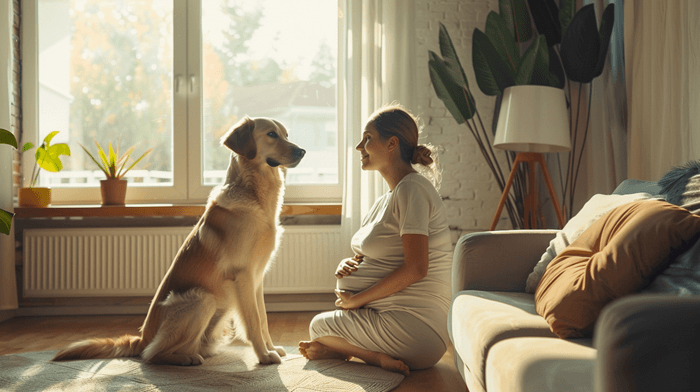
The joy of expecting a baby comes with a lot of changes for everyone in the household, including your dog. Dogs are sensitive to changes in their environment, and the arrival of a newborn can be an overwhelming experience for them. A dog that has been the center of attention may now face a new family member who takes up much of their owner’s time and attention. This transition, if not managed properly, can result in anxiety, confusion, or even behavioral problems.
Fortunately, by starting the preparation process early and using the right techniques, you can help your dog adjust smoothly to the new dynamics. Preparing your dog for the arrival of a baby is essential to ensure the safety of both your pet and your child while maintaining a harmonious household.
In this detailed guide, we’ll explore why it’s important to prepare your dog for a baby, the step-by-step training process to follow, common mistakes to avoid, and scientific backing on dog-baby relationships. We’ll also dive into common challenges and how to overcome them, ensuring that your dog feels loved and included as your family grows.
Why Preparing Your Dog for a Baby is Crucial
As a dog owner, your pet is not just an animal, but a cherished member of your family. When a baby enters the picture, your dog may find it difficult to adapt to the new sounds, smells, routines, and lack of attention. The anxiety and confusion caused by these changes can lead to problematic behaviors, such as barking, growling, or even aggression.
Early preparation is key to preventing these issues. By helping your dog adapt to the idea of a new family member, you reduce the risk of stress and ensure a smooth transition for everyone involved. A well-prepared dog is more likely to behave calmly and respectfully around the baby, while also understanding their new role within the family structure.
This guide will walk you through the most effective strategies to prepare your dog for a new baby, ensuring that both your dog and child live in harmony.
Benefits of Preparing Your Dog for a Baby’s Arrival
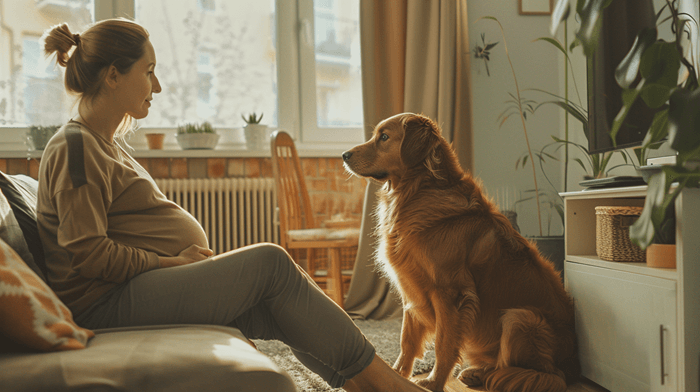
Before diving into the step-by-step process, let’s look at the key benefits of preparing your dog for the arrival of a newborn:
1. Reduced Anxiety in Dogs
Dogs thrive on routine and familiarity. Sudden changes in their environment, such as new sounds, smells, and disruptions to their daily schedule, can trigger anxiety. By gradually introducing these changes and providing positive reinforcement, you can significantly reduce the likelihood of stress-related behaviors.
For instance, playing baby sounds and exposing your dog to baby gear well in advance will desensitize them to these new stimuli. This gradual exposure reduces the shock of the baby’s arrival and helps your dog remain calm and confident during the transition.
2. Improved Safety for Baby and Dog
One of the main reasons to prepare your dog for a baby is to ensure safety. While many dogs are gentle and loving, they may inadvertently behave in a way that could harm a baby, especially if they are not accustomed to small children. This could include jumping on the baby, nipping, or displaying territorial behavior around toys or furniture.
By reinforcing obedience commands and setting clear boundaries, you can prevent unwanted interactions between your dog and the baby, keeping both of them safe. Proper training allows your dog to understand that the baby is part of the family and should be treated with care and respect.
3. Easier Transition for Your Dog
A well-prepared dog is less likely to feel displaced or neglected when the baby arrives. Dogs are social creatures, and when a baby takes up much of your time and attention, your dog may feel left out. Early preparation, such as adjusting their routine and ensuring they still receive plenty of love and attention, will help your dog feel secure in their place within the family.
4. Stronger Bond Between Baby and Dog
When introduced correctly, a baby and a dog can form a beautiful, lifelong bond. Dogs often become protective and affectionate toward babies, acting as companions and guardians as the child grows. By fostering a positive relationship from the start, you’ll create an environment where both your dog and child can thrive together.
5. Peace of Mind for Parents
For parents, knowing that their dog has been properly trained and is comfortable with the new baby offers peace of mind. You won’t have to constantly worry about your dog’s reaction to the baby or fear potential accidents or aggressive behavior. This reduces stress for the entire household, allowing you to focus on enjoying the new addition to your family.
Step-by-Step Guide: How to Prepare Your Dog for a Baby
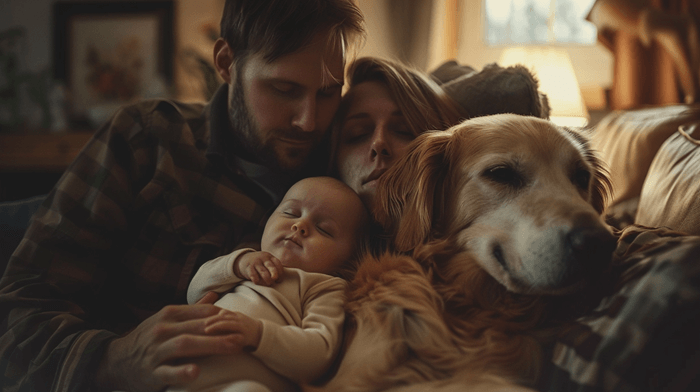
Now that we understand the importance of preparation, let’s dive into the practical steps you can take to help your dog adjust to a new baby in the household. Follow this step-by-step guide to ensure a smooth transition.
Step 1: Gradual Introduction to Baby Sounds and Smells
Babies bring a whole new range of sounds and smells into the home that your dog may find unsettling. From crying to giggling, your dog needs to get used to these new sounds to avoid anxiety or barking fits. Here’s how to introduce these stimuli:
Introduce Baby Sounds
Start by playing recordings of baby noises, such as crying, cooing, and giggling, at a low volume. Gradually increase the volume over time as your dog becomes more comfortable. Praise your dog and give treats when they remain calm, creating a positive association with these new sounds.
You can find baby sound recordings on various apps, YouTube, or even purchase CDs specifically designed for this purpose. Aim to expose your dog to these sounds for about 5-10 minutes each day in the weeks leading up to the baby’s arrival.
Expose Your Dog to Baby Scents
Dogs rely heavily on their sense of smell to understand their environment. Before the baby arrives, introduce your dog to the scents associated with newborns, such as baby powder, lotions, and clothing. After the baby is born, bring home a blanket or piece of clothing the baby has worn so your dog can get accustomed to the baby’s unique scent before they meet.
Practical Tip:
Use treats or praise to reward calm behavior when exposing your dog to these new stimuli. Positive reinforcement helps build confidence and reduces anxiety.
Step 2: Adjust Your Dog’s Routine Early
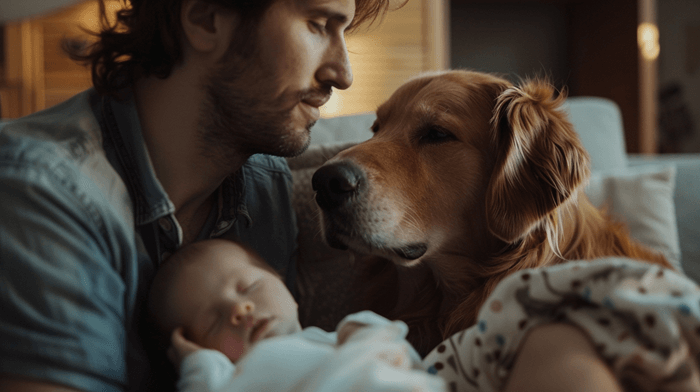
Dogs are creatures of habit, and changes to their daily routine can be stressful. The arrival of a baby often disrupts the usual feeding, walking, and playtime schedule, so it’s crucial to start adjusting your dog’s routine well in advance.
Gradual Schedule Changes
If you anticipate that your dog’s walk or feeding times will change after the baby arrives, start making those adjustments now. For example, if you currently walk your dog in the morning but plan to switch to the afternoon after the baby is born, gradually shift the walk time over several weeks. This will help your dog adapt to the new routine without feeling neglected or stressed.
Maintain Consistency
While some adjustments are necessary, it’s important to maintain consistency in certain areas, such as feeding and exercise. Even after the baby arrives, make an effort to stick to a regular feeding schedule and provide your dog with daily exercise and mental stimulation. A well-exercised dog is less likely to exhibit anxiety or destructive behaviors.
Practical Tip:
If possible, enlist the help of a partner or family member to ensure your dog still receives plenty of attention and exercise once the baby arrives.
Step 3: Introduce Baby Equipment Gradually

Baby gear, such as strollers, cribs, and swings, can be confusing or even frightening for a dog. Start setting up the baby’s room and equipment well in advance to give your dog time to adjust to these new objects in the home.
Familiarize Your Dog with Strollers
Take your dog on walks with an empty stroller before the baby arrives. This will help them get used to walking alongside the stroller and prevent anxiety or leash-pulling when the baby is finally in the stroller. Reward calm behavior with treats and praise.
Let Your Dog Explore Baby Gear
Allow your dog to investigate the baby’s crib, swing, and other equipment while they are stationary. Once your dog is comfortable, start moving these items (e.g., rocking the swing) and observe how your dog reacts. If they remain calm, offer positive reinforcement to build a positive association with the baby’s things.
Practical Tip:
Consider using a baby gate to keep your dog out of certain areas, such as the baby’s room. This helps establish clear boundaries and prevents your dog from becoming overly curious or territorial about the baby’s space.
Step 4: Strengthen Basic Obedience Commands
A well-trained dog is much easier to manage when a baby arrives. Reinforcing basic obedience commands ensures that your dog listens to you in potentially chaotic or distracting situations, keeping both your dog and baby safe.
Key Commands to Reinforce:
- Sit: Teach your dog to sit calmly when instructed. This is particularly useful when introducing your dog to the baby, as it prevents jumping or excessive excitement.
- Stay: The stay command is essential for keeping your dog at a safe distance from the baby or baby gear when necessary.
- Come: This command ensures that your dog comes to you immediately, even if they are distracted by the baby or other stimuli.
- Down: Teaching your dog to lie down on command is helpful in keeping them calm during interactions with the baby.
Practice in Different Environments
To ensure your dog reliably follows commands, practice in different environments and gradually increase distractions. For example, practice commands while playing baby sounds in the background or while pushing a stroller.
Practical Tip:
Use positive reinforcement methods, such as treats and praise, to reward good behavior. Avoid punishment-based training, as it can increase anxiety and hinder your dog’s ability to adjust to the new baby.
Common Challenges and How to Overcome Them
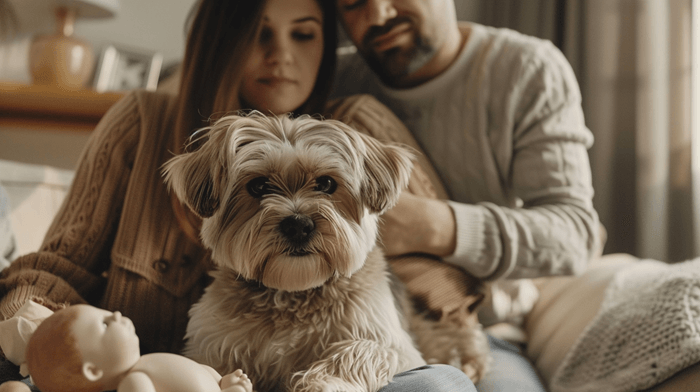
While many dogs adjust well to a new baby with proper preparation, some challenges may arise. Here are some common issues and how to address them:
Challenge 1: Jealousy or Attention-Seeking Behavior
Dogs can feel left out when a new baby arrives and takes up most of your time and attention. This may result in behaviors like excessive barking, whining, or even destructive tendencies. They might also try to insert themselves between you and the baby during feeding or playtime, seeking the attention they used to get.
Solution:
- Keep Giving Your Dog Attention: While your time may be more limited after the baby arrives, try to dedicate specific periods throughout the day to spend with your dog. Whether it’s during a walk, a short play session, or just sitting with them while the baby naps, this will reassure them that they are still valued and loved.
- Reward Calm Behavior: When your dog behaves calmly around the baby or shows signs of good behavior, reward them with treats or affection. Over time, they’ll learn that good behavior around the baby earns them positive attention.
- Incorporate Your Dog in Baby-Related Activities: Instead of excluding your dog, try to involve them in activities related to the baby. For example, let your dog sit quietly beside you while you feed the baby, or bring them along for stroller walks. This helps the dog associate positive experiences with the baby’s presence.
Challenge 2: Anxiety Around the Baby
Some dogs, especially those with naturally timid or anxious personalities, may feel overwhelmed by the noises and movements of a newborn. This anxiety could manifest as pacing, hiding, or even excessive barking when the baby cries.
Solution:
- Desensitize Your Dog to Baby Sounds: As mentioned earlier, start playing baby sounds at a low volume and gradually increase the intensity over time. This prepares your dog for the real-life sounds they’ll hear once the baby arrives. Continue to praise and reward calm behavior to reinforce that these sounds aren’t a threat.
- Create a Safe Space: Make sure your dog has a quiet, safe place where they can retreat if they feel overwhelmed. This could be a crate, a separate room, or a cozy bed in a corner. Encourage your dog to use this space whenever they need a break from the baby-related activities.
- Practice Gradual Introductions: Introduce your dog to the baby gradually, keeping early interactions short and positive. Over time, as your dog becomes more comfortable, you can allow them to spend more time around the baby.
Challenge 3: Resource Guarding
Some dogs may become territorial about their toys, beds, or even you when the baby arrives. This could lead to resource guarding behaviors, such as growling or snapping if the baby approaches their belongings or space.
Solution:
- Teach Boundaries: Well before the baby arrives, teach your dog that certain areas or objects are off-limits. For instance, if your dog is allowed on the couch, but you plan to use that space for nursing the baby, begin to teach them a “no couch” rule before the baby arrives.
- Manage the Environment: Keep the baby and the dog’s belongings separate. For example, place the dog’s toys and bed in a different room from where the baby plays. This reduces the chances of the baby accidentally taking something that belongs to the dog, which could trigger a protective response.
- Positive Reinforcement for Sharing: If your dog has difficulty sharing space or toys, practice giving them high-value treats when they allow you to touch their belongings or sit near them. This teaches them that sharing isn’t a threat and is, in fact, rewarding.
Challenge 4: Hyperactivity or Overexcitement
Dogs with high energy levels may struggle to control their excitement around a baby. They might jump on you while you’re holding the baby, or try to lick or nudge the baby when they get too close.
Solution:
- Provide Plenty of Physical and Mental Stimulation: A well-exercised dog is less likely to become overly excited or act out. Make sure your dog gets daily exercise, such as long walks, playtime, or agility training. Mental stimulation, such as puzzle toys or obedience training, can also help expend excess energy.
- Train Calm Behaviors: Reinforce calm behaviors, such as sitting or lying down, whenever your dog is around the baby. You can use a command like “settle” to signal that they need to be calm in the baby’s presence. Reward them generously when they obey.
- Use a Leash for Controlled Interactions: If your dog struggles with impulse control, keep them on a leash during initial interactions with the baby. This allows you to manage their movements and prevent any sudden excitement from overwhelming the baby.
Common Mistakes to Avoid When Preparing Your Dog for a Baby

Even with the best intentions, it’s easy to make mistakes when introducing your dog to a baby. Here are some common pitfalls to watch out for:
Mistake 1: Waiting Until the Last Minute to Prepare
One of the most common mistakes is waiting too long to start preparing your dog for the baby’s arrival. Training and desensitization take time, and sudden changes can overwhelm your dog.
How to Avoid It:
Begin preparation as early as possible, ideally several months before the baby arrives. Gradually introduce new routines, sounds, and equipment, so your dog has time to adjust.
Mistake 2: Neglecting the Dog After the Baby Arrives
It’s understandable that new parents are often exhausted and overwhelmed in the early weeks of a baby’s life, but neglecting your dog during this period can lead to behavioral problems or feelings of abandonment.
How to Avoid It:
Make a conscious effort to continue spending quality time with your dog. Even short, focused interactions, like a 10-minute play session or a quick cuddle, can help your dog feel included.
Mistake 3: Failing to Set Boundaries
Some parents feel guilty about setting boundaries for their dog once a baby arrives, but clear boundaries are essential for a harmonious household. Dogs need to understand that certain areas or behaviors are off-limits, especially when it comes to the baby’s space.
How to Avoid It:
Introduce boundaries early and be consistent in enforcing them. For example, if you don’t want your dog in the baby’s room, start teaching them this rule well before the baby arrives.
Mistake 4: Punishing Negative Behavior Instead of Redirecting It
If your dog acts out due to the changes in the household, it’s important to avoid punishment. Punishing negative behavior, such as barking or jumping, can increase anxiety and make the transition harder for your dog.
How to Avoid It:
Use positive reinforcement to encourage good behavior and redirect negative behavior. For example, if your dog jumps on you while holding the baby, ask them to sit instead and reward them for complying.
Mistake 5: Not Supervising Early Interactions
Even if your dog is well-behaved, it’s essential to supervise their interactions with the baby, especially during the early days. Babies are fragile, and even a well-meaning dog could accidentally cause harm through rough play or overexcitement.
How to Avoid It:
Always supervise any interactions between your dog and the baby. Never leave them alone together, especially in the first few months. Gradually, as both the dog and the baby grow accustomed to each other, you can allow more freedom—but always remain cautious.
Scientific Support for the Benefits of Dog-Baby Relationships
The benefits of a positive relationship between dogs and babies are supported by scientific research. Studies show that children who grow up with pets, especially dogs, tend to have better emotional and social development. Here are some key findings:
1. Improved Social Skills
Research published in the journal Pediatric Research found that children who grow up with dogs tend to have better social skills and emotional regulation. Interacting with a pet teaches children empathy, responsibility, and non-verbal communication.
2. Lower Risk of Allergies
Contrary to popular belief, growing up with a dog may actually reduce a child’s risk of developing allergies. A study published in The Journal of Allergy and Clinical Immunology found that exposure to dogs in early childhood is linked to a reduced risk of asthma and allergies later in life.
3. Emotional Support and Stress Reduction
Dogs provide comfort and emotional support to children, especially during stressful times. Studies have shown that the presence of a dog can reduce cortisol levels (a stress hormone) and promote feelings of calm and security.
4. Physical Activity
Having a dog encourages more physical activity, which is beneficial for children’s physical health. A study published in The American Journal of Public Health found that children with dogs are more likely to engage in regular outdoor play and exercise.
5. Enhanced Immune System
Dogs bring beneficial bacteria into the home, which can help strengthen a baby’s immune system. A study published in Proceedings of the National Academy of Sciences found that children raised in homes with dogs had a more diverse gut microbiome, which is linked to better overall health.
Conclusion: Preparing Your Dog for a Baby’s Arrival is a Lifelong Gift
Preparing your dog for the arrival of a new baby is not just about preventing problems in the short term. It’s about creating a loving, harmonious environment where your dog and child can grow up together, developing a bond that will last a lifetime.
By following the steps outlined in this guide—introducing baby sounds and smells, adjusting routines, setting boundaries, and reinforcing positive behaviors—you’ll set your dog up for success. Remember, a well-prepared dog is a happy dog, and with patience, love, and training, your dog and baby can coexist peacefully.
Now that you’re equipped with the knowledge and strategies to prepare your dog for the arrival of a baby, it’s time to put these insights into action. Each step you take will not only help your dog adjust but will also create a nurturing environment for your new family member.
Don’t wait until the last minute to start preparing! Begin today by implementing small changes in your routine. Spend time desensitizing your dog to baby sounds, setting boundaries, and giving them the attention they deserve. Your commitment to this preparation will ensure a smooth transition and a lifetime of cherished memories for both your dog and your child. Embrace the journey of welcoming your new baby into a home filled with love, respect, and the companionship of your four-legged friend.
